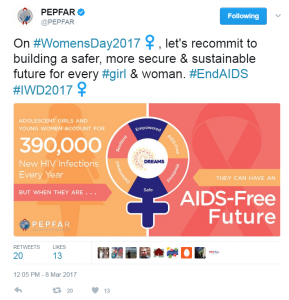International Women's Day 2017: A Time for Action
Topics
Editor’s Note: Today we observe National Women and Girls HIV AIDS Awareness Day and on Tuesday we observed International Women’s Day. Read below to learn more about our international colleagues acknowledged that day and the work they do with women and HIV.
Today, on International Women's Day, we celebrate the critical progress made toward advancing the economic future of adolescent girls and young women and we recommit ourselves to expanding their access to education, health care, and jobs.
Far too many women and girls around the world still face barriers to accessing these fundamental opportunities. Every year, 390,000 adolescent girls and young women are infected with HIV -- more than 1,000 a day. In sub-Saharan Africa, the numbers are even more staggering: nearly three out of four adolescents newly infected with HIV are female, and in some countries young women are up to 14 times more likely to contract HIV than young men.

Many factors increase girls’ vulnerability to HIV, including a lack of access to secondary school, sexual violence, harmful traditional practices, and exclusion from economic opportunities. Ninety-eight million girls around the world are not in school, yet we know that a girl who has a basic education is three times less likely to contract HIV. Girls who experience violence are up to three times more likely to be infected with HIV or other sexually transmitted infections; Violence Against Children Surveys conducted in 11 countries found that an average of one in three young women reported their first sexual experience as forced or coerced.
This must change. The U.S. President’s Emergency Plan for AIDS Relief (PEPFAR) is driving efforts to ensure girls can grow into Determined, Resilient, Empowered, AIDS-free, Mentored, and Safe women through our DREAMS public-private partnership with the Bill & Melinda Gates Foundation, Girl Effect, Johnson & Johnson, Gilead Sciences, and ViiV Healthcare. Our complementary DREAMS Innovation Challenge is supporting creative and community-based approaches to meet local needs. Together, we are strengthening families, keeping girls in school and safe from sexual violence, avoiding and reducing risk, and providing a bridge to employment for young women.

The early results speak for themselves. In its first year of implementation, DREAMS reached one million adolescent girls and young women with interventions to address the factors that increase their risk for HIV infection. But this is only the beginning. Much more work remains and there is no time to waste. The population of young women in sub-Saharan Africa is expected to increase to more than 200 million by the year 2020, doubling the number in 1990, so it is more critical than ever that we act with urgency and focus.
PEPFAR’s efforts, alongside our many partners, are changing the very course of the HIV/AIDS pandemic. The American people, through PEPFAR, are supporting life-saving treatment for almost 11.5 million men, women, and children. We have prevented nearly two million babies from being born with HIV. And PEPFAR is providing critical care and support for close to 6.2 million orphans, vulnerable children, and their caregivers to mitigate the physical, emotional, and economic impact of HIV/AIDS on children.
Ending the AIDS epidemic by 2030 is possible, but only if we empower, protect, and support adolescent girls and young women. On this International Women's Day, we are more determined than ever to build a safer, more secure, and sustainable future for them, so they can grow up healthy and AIDS-free.